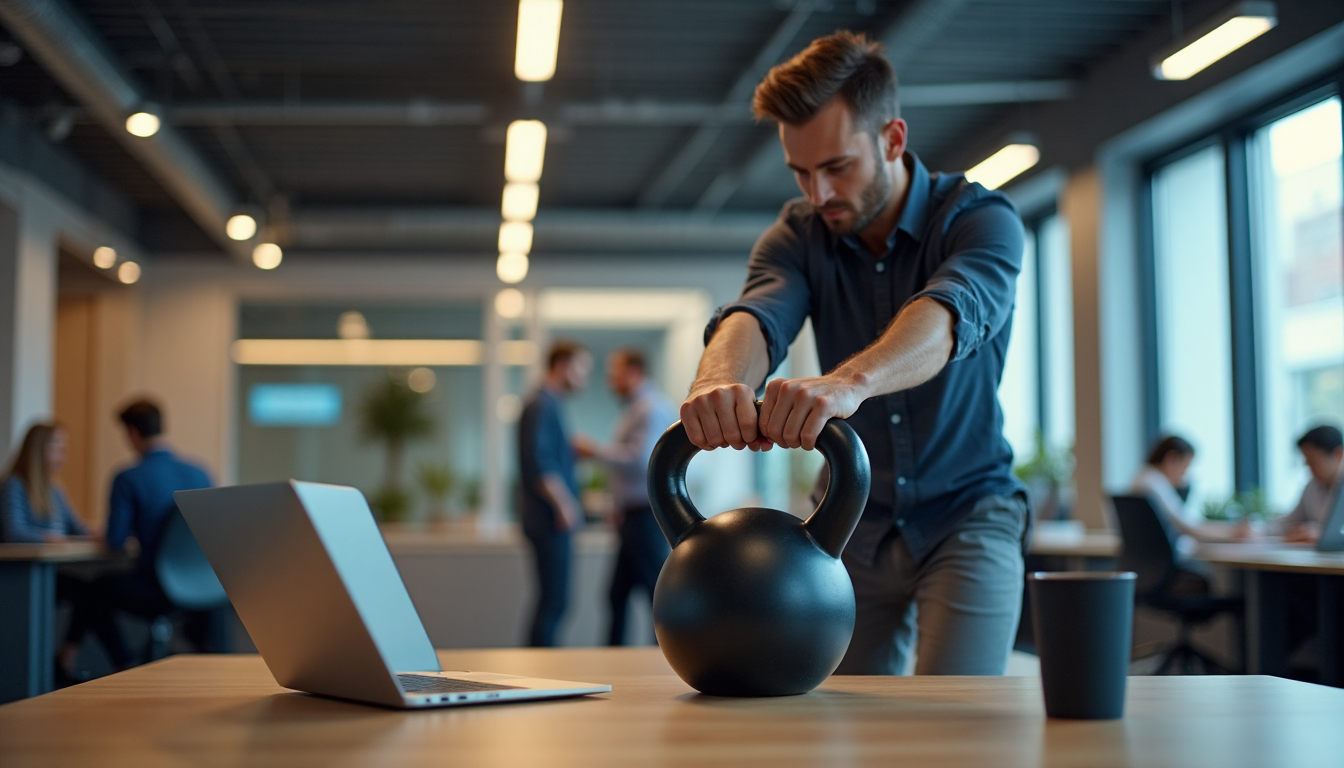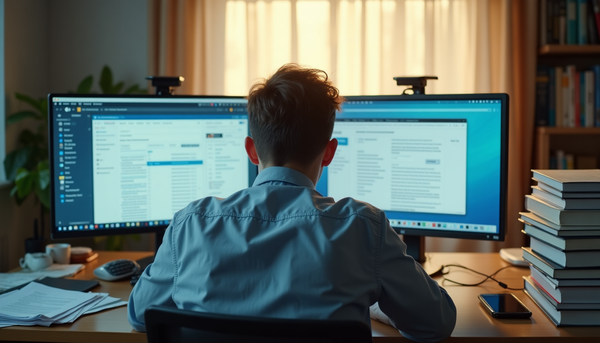Why I Keep a Kettlebell Under My Desk (And You Should Too)

Why I Keep a Kettlebell Under My Desk (And You Should Too)
Let me paint you a picture. It's 3 PM on a Wednesday. You're staring at your laptop screen, feeling that familiar afternoon slump creeping in like an unwelcome relative. Your back's starting to ache, your brain feels like it's swimming through molasses, and you've got three more hours of "productivity" ahead of you.
Now here's what I do: I reach under my desk, grab my trusty 16kg kettlebell (yes, it lives there), and bang out 50 swings in about 90 seconds.
My colleagues think I'm slightly unhinged. My energy levels? They think I'm magic.
The Gym Membership Lie We Keep Telling Ourselves
Here's the uncomfortable truth nobody wants to admit: that gym membership you're paying for? It's not working. And it's not because you lack willpower or discipline.
It's because the entire premise is fundamentally broken.
We've been conditioned to believe that fitness happens in special places, wearing special clothes, for special durations. It's like saying you can only drink water from a fountain in the town square between 6-7 AM.
Ridiculous, right?
Yet somehow we've convinced ourselves that movement—something our bodies literally crave every few hours—should be crammed into a single 60-minute window, preferably before dawn or after we're already exhausted from work.
I used to be one of those people. You know the type:
- Paid for a premium gym membership ✓
- Bought the fancy workout gear ✓
- Downloaded seven different fitness apps ✓
- Actually went to the gym... maybe twice a month ✗
The breaking point came during a particularly brutal quarter at my consulting firm. I was pulling 70-hour weeks, living on coffee and whatever sad desk salads I could grab from the lobby café. My back was constantly tight, I was getting sick every month, and I felt like my body was staging a revolt.
That's when I discovered something the fitness industry doesn't want you to know.
The Stealth Fitness Revolution
Movement doesn't need to be an event. It can be a punctuation mark in your day.
Think about it: you don't save up all your coffee drinking for one massive caffeine binge at 6 AM. You sip throughout the day when you need it. Why should movement be any different?
Enter what I call "stealth fitness"—exercise so seamlessly integrated into your workday that it becomes as natural as checking email.
The kettlebell is the perfect weapon for this revolution. Here's why:
It's ridiculously space-efficient. One kettlebell takes up less room than a briefcase and can deliver a full-body workout that puts most gym sessions to shame.
It's time-efficient. I'm talking 2-5 minute movement breaks that actually energize you instead of depleting you.
It's social-proof efficient. Nobody needs to know you're "working out." You're just... moving a weight around for a minute. No big deal.
Breaking Through the Psychological Barriers
But let's address the elephant in the room—or should I say, the kettlebell under the desk.
"What will people think?"
Here's what I've learned after three years of desk-side kettlebell swings: people are way too busy worrying about their own stuff to judge your 60-second movement breaks. In fact, most of them are secretly envious.
I started getting comments like:
- "Wow, you always seem so energetic in afternoon meetings"
- "How do you stay so focused during those long strategy sessions?"
- "You never seem to get that 3 PM crash"
Nobody connected it to the weird guy swinging a weight by his desk. They just noticed the results.
"I don't have space/privacy."
Listen, I get it. Not everyone has a private office where they can grunt and swing without judgment. But here's the thing—most kettlebell movements are surprisingly quiet and compact.
My current setup? I work from a shared co-working space. My "gym" is a 6x6 foot area behind my desk. My workout clothes? Whatever I wore to work that day.
"I don't know how to use a kettlebell."
This one's valid. A kettlebell isn't like a dumbbell—it has its own movement vocabulary. But here's the beautiful part: you only need to master 3-4 basic movements to unlock 80% of the benefits.
The Stealth Fitness Playbook
Here's my actual system—the one that's kept me consistently active for three years while building two businesses and maintaining my sanity.
The Four-Alarm Method
I set four alarms on my phone:
- 9 AM: Morning activation
- 12 PM: Pre-lunch energy boost
- 3 PM: Afternoon revival
- 6 PM: End-of-day transition
Each alarm triggers a 2-5 minute movement break. That's it. No changing clothes, no shower requirements, no travel time.
The Essential Four Movements
1. Kettlebell Swings (The Swiss Army Knife)
- 30-60 seconds of two-handed swings
- Hits your posterior chain, gets your heart pumping
- Looks like you're just... swinging something
2. Goblet Squats (The Desk Antidote)
- 10-15 slow, controlled squats holding the kettlebell
- Counteracts all that sitting
- Can be done in business casual
3. Suitcase Carries (The Stealth Walk)
- Pick up kettlebell, walk around for 60-90 seconds
- Incredible for posture and core stability
- Looks like you're carrying something heavy (which you are)
4. Bottoms-Up Press (The Grip Strengthener)
- Hold kettlebell upside down, press overhead
- Amazing for shoulder stability and focus
- Quietly builds serious strength
My Actual Wednesday Schedule
Let me show you how this looks in practice:
9:00 AM - Just finished my first batch of emails Movement break: 60 seconds of swings while my coffee brews
12:00 PM - About to break for lunch Movement break: Walk the hallway with suitcase carries for 90 seconds
3:00 PM - Energy starting to dip Movement break: 15 goblet squats, then 30 seconds of swings
6:00 PM - Wrapping up for the day Movement break: 5 bottoms-up presses each arm
Total "workout" time: About 8 minutes Total energy gained: Immeasurable Total gym membership fees: $0 Total excuses about not having time: Also $0
The Unexpected Benefits
Here's what nobody tells you about micro-workouts throughout the day:
Your brain actually works better. I'm not talking about some vague "feeling more energetic." I mean measurably sharper thinking, better problem-solving, improved memory. Movement breaks are like hitting the reset button on your cognitive function.
Your posture improves without trying. All those hours hunched over a laptop start to matter less when you're regularly activating your posterior chain and core.
You sleep better. Instead of one massive workout that might amp you up, these small movement doses throughout the day create a natural rhythm that promotes better sleep.
You actually look forward to exercise. When movement becomes a relief from mental work instead of another item on your to-do list, everything changes.
Real Talk: The Challenges
I'm not going to pretend this is all sunshine and kettlebell swings. There are real challenges:
The learning curve is real. Kettlebells aren't intuitive. I spent my first month watching YouTube videos and practicing form. Plan for this.
Storage can be annoying. A 16kg kettlebell isn't huge, but it's also not invisible. I've had to negotiate with office managers and convince landlords that it's not going to damage floors.
You will get comments. Most are positive or curious, but a few people will think you're weird. I've learned to own it.
Consistency is still hard. Even with 2-minute workouts, I still sometimes ignore my alarms when I'm deep in a project.
Getting Started Without Overwhelm
If you're intrigued but not ready to fully commit to the kettlebell-under-desk lifestyle, here's how to test the waters:
Week 1-2: Just set the alarms Don't even buy a kettlebell yet. Just set four alarms and do bodyweight movements—squats, push-ups against your desk, walk around the building.
Week 3-4: Add variety If you're actually doing the movement breaks (be honest), add some complexity. Try single-leg stands, desk-supported lunges, or wall sits.
Week 5+: Introduce the kettlebell Start light—12kg for most women, 16kg for most men. Focus on form over intensity.
The Question That Changes Everything
Here's what I want you to ask yourself: What if exercise wasn't something you had to find time for, but something that actually gave you more time by making your work hours more productive?
That's the real magic of stealth fitness. It's not about cramming more stuff into your day. It's about using strategic movement to make the time you have more valuable.
Three years ago, I was the guy making excuses about not having time for the gym while simultaneously spending 30 minutes scrolling LinkedIn between meetings.
Now? I move more than I ever did with a gym membership, I'm stronger and more energetic, and I haven't lost a single minute of productivity. If anything, I've gained hours of high-quality focus time.
Your Move
So here's my challenge to you: for the next week, set just one alarm. 3 PM. When it goes off, do something—anything—that involves moving your body for 60 seconds.
Walk to the bathroom. Do five squats. Stretch your arms overhead. Just move.
If you can do that for five days, you're ready for the kettlebell revolution.
And if you're already convinced? Start shopping for a kettlebell. Get one that feels challenging but manageable. Put it somewhere visible in your workspace.
Then join the ranks of people who stopped waiting for the perfect time to exercise and started creating it instead.
Trust me, your 3 PM self will thank you.
What's your biggest barrier to consistent movement during the workday? Drop a comment and let's problem-solve together. And if you're already doing desk-side workouts, share your favorite movements—I'm always looking for new additions to the arsenal.




